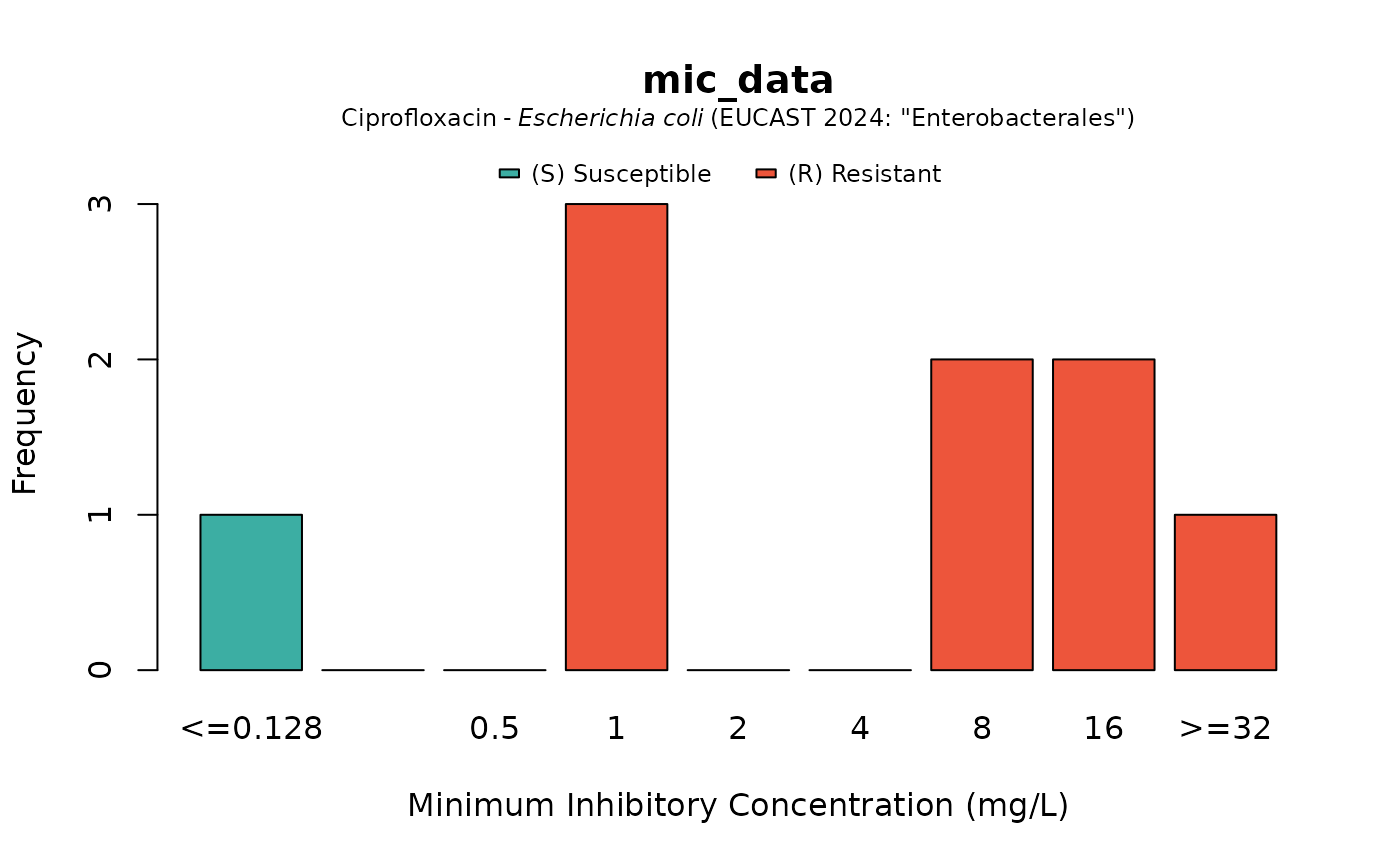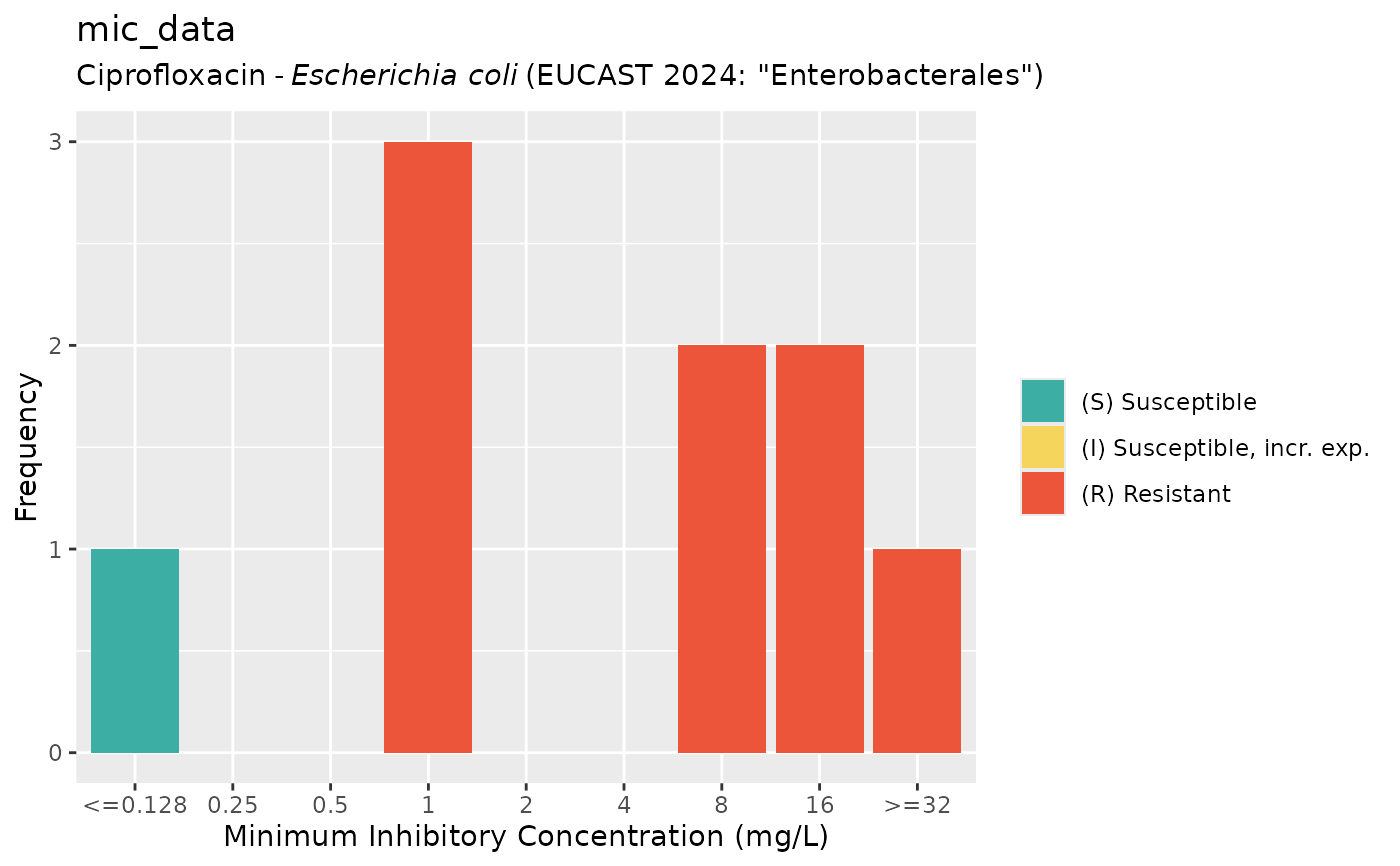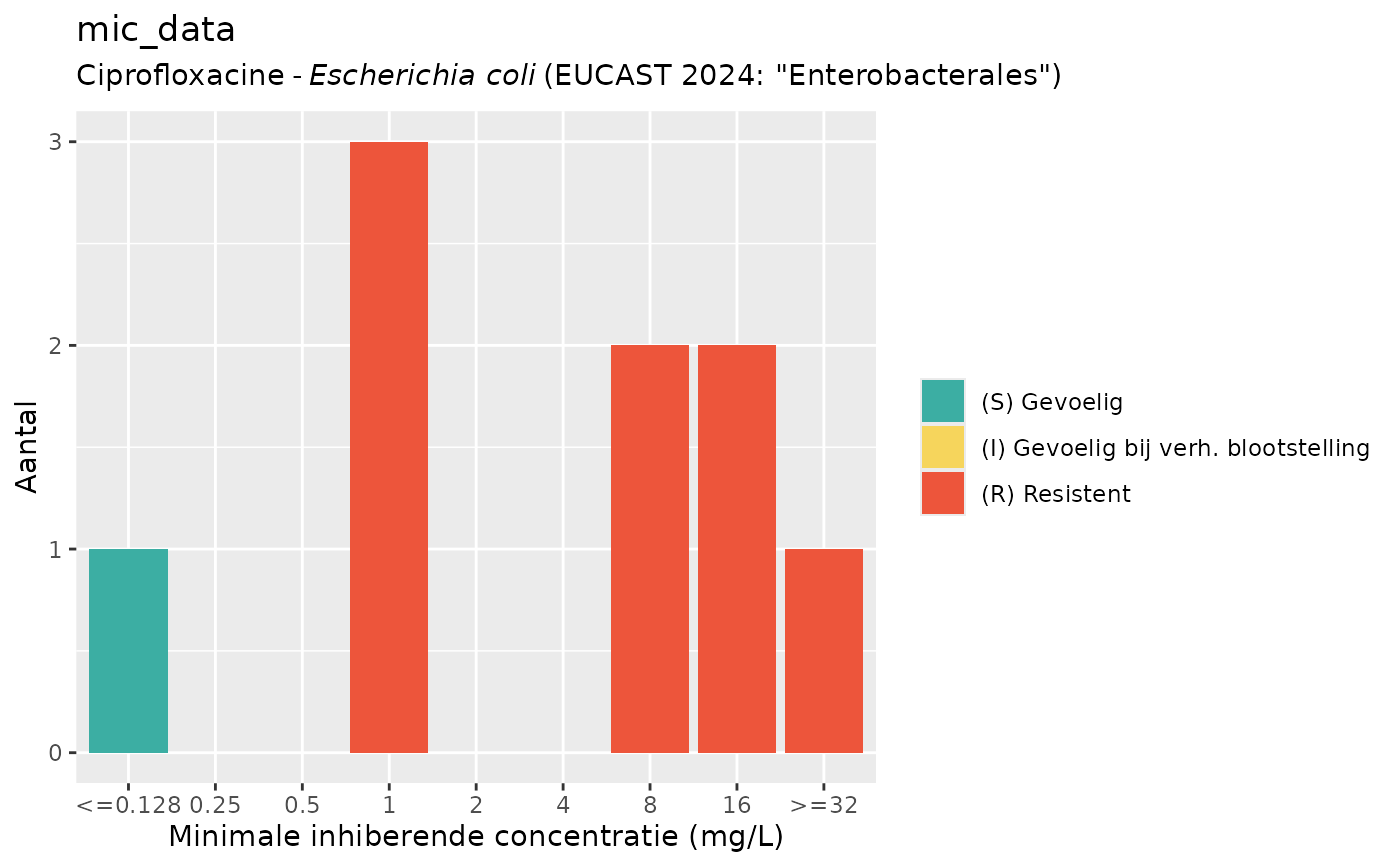This transforms vectors to a new class mic, which treats the input as decimal numbers, while maintaining operators (such as ">=") and only allowing valid MIC values known to the field of (medical) microbiology.
Usage
as.mic(x, na.rm = FALSE, keep_operators = "all")
is.mic(x)
NA_mic_
rescale_mic(x, mic_range, keep_operators = "edges", as.mic = TRUE)
# S3 method for mic
droplevels(x, as.mic = FALSE, ...)Arguments
- x
- na.rm
a logical indicating whether missing values should be removed
- keep_operators
a character specifying how to handle operators (such as
>and<=) in the input. Accepts one of three values:"all"(orTRUE) to keep all operators,"none"(orFALSE) to remove all operators, or"edges"to keep operators only at both ends of the range.- mic_range
a manual range to limit the MIC values, e.g.,
mic_range = c(0.001, 32). UseNAto set no limit on one side, e.g.,mic_range = c(NA, 32).- as.mic
a logical to indicate whether the
micclass should be kept - the default isFALSE- ...
arguments passed on to methods
Value
Ordered factor with additional class mic, that in mathematical operations acts as a numeric vector. Bear in mind that the outcome of any mathematical operation on MICs will return a numeric value.
Details
To interpret MIC values as SIR values, use as.sir() on MIC values. It supports guidelines from EUCAST (2011-2024) and CLSI (2011-2024).
This class for MIC values is a quite a special data type: formally it is an ordered factor with valid MIC values as factor levels (to make sure only valid MIC values are retained), but for any mathematical operation it acts as decimal numbers:
x <- random_mic(10)
x
#> Class 'mic'
#> [1] 16 1 8 8 64 >=128 0.0625 32 32 16
is.factor(x)
#> [1] TRUE
x[1] * 2
#> [1] 32
median(x)
#> [1] 26This makes it possible to maintain operators that often come with MIC values, such ">=" and "<=", even when filtering using numeric values in data analysis, e.g.:
x[x > 4]
#> Class 'mic'
#> [1] 16 8 8 64 >=128 32 32 16
df <- data.frame(x, hospital = "A")
subset(df, x > 4) # or with dplyr: df %>% filter(x > 4)
#> x hospital
#> 1 16 A
#> 5 64 A
#> 6 >=128 A
#> 8 32 A
#> 9 32 A
#> 10 16 AAll so-called group generic functions are implemented for the MIC class (such as !, !=, <, >=, exp(), log2()). Some functions of the stats package are also implemented (such as quantile(), median(), fivenum()). Since sd() and var() are non-generic functions, these could not be extended. Use mad() as an alternative, or use e.g. sd(as.numeric(x)) where x is your vector of MIC values.
Using as.double() or as.numeric() on MIC values will remove the operators and return a numeric vector. Do not use as.integer() on MIC values as by the R convention on factors, it will return the index of the factor levels (which is often useless for regular users).
Use droplevels() to drop unused levels. At default, it will return a plain factor. Use droplevels(..., as.mic = TRUE) to maintain the mic class.
With rescale_mic(), existing MIC ranges can be limited to a defined range of MIC values. This can be useful to better compare MIC distributions.
For ggplot2, use one of the scale_*_mic() functions to plot MIC values. They allows custom MIC ranges and to plot intermediate log2 levels for missing MIC values.
NA_mic_ is a missing value of the new mic class, analogous to e.g. base R's NA_character_.
Examples
mic_data <- as.mic(c(">=32", "1.0", "1", "1.00", 8, "<=0.128", "8", "16", "16"))
mic_data
#> Class 'mic'
#> [1] >=32 1 1 1 8 <=0.128 8 16 16
is.mic(mic_data)
#> [1] TRUE
# this can also coerce combined MIC/SIR values:
as.mic("<=0.002; S")
#> Class 'mic'
#> [1] <=0.002
# mathematical processing treats MICs as numeric values
fivenum(mic_data)
#> [1] 0.128 1.000 8.000 16.000 32.000
quantile(mic_data)
#> 0% 25% 50% 75% 100%
#> 0.128 1.000 8.000 16.000 32.000
all(mic_data < 512)
#> [1] TRUE
# limit MICs using rescale_mic()
rescale_mic(mic_data, mic_range = c(4, 16))
#> Class 'mic'
#> [1] >=16 <=4 <=4 <=4 8 <=4 8 >=16 >=16
# interpret MIC values
as.sir(
x = as.mic(2),
mo = as.mo("Streptococcus pneumoniae"),
ab = "AMX",
guideline = "EUCAST"
)
#> ℹ Run sir_interpretation_history() afterwards to retrieve a logbook with
#> all the details of the breakpoint interpretations. Note that some
#> microorganisms might not have breakpoints for each antimicrobial drug in
#> EUCAST 2024.
#> Interpreting MIC values: 'AMX' (amoxicillin), EUCAST 2024...
#> OK
#> Class 'sir'
#> [1] R
as.sir(
x = as.mic(c(0.01, 2, 4, 8)),
mo = as.mo("Streptococcus pneumoniae"),
ab = "AMX",
guideline = "EUCAST"
)
#> ℹ Run sir_interpretation_history() afterwards to retrieve a logbook with
#> all the details of the breakpoint interpretations. Note that some
#> microorganisms might not have breakpoints for each antimicrobial drug in
#> EUCAST 2024.
#> Interpreting MIC values: 'AMX' (amoxicillin), EUCAST 2024...
#> OK
#> Class 'sir'
#> [1] S R R R
# plot MIC values, see ?plot
plot(mic_data)
 plot(mic_data, mo = "E. coli", ab = "cipro")
plot(mic_data, mo = "E. coli", ab = "cipro")
 if (require("ggplot2")) {
autoplot(mic_data, mo = "E. coli", ab = "cipro")
}
if (require("ggplot2")) {
autoplot(mic_data, mo = "E. coli", ab = "cipro")
}
 if (require("ggplot2")) {
autoplot(mic_data, mo = "E. coli", ab = "cipro", language = "nl") # Dutch
}
if (require("ggplot2")) {
autoplot(mic_data, mo = "E. coli", ab = "cipro", language = "nl") # Dutch
}
